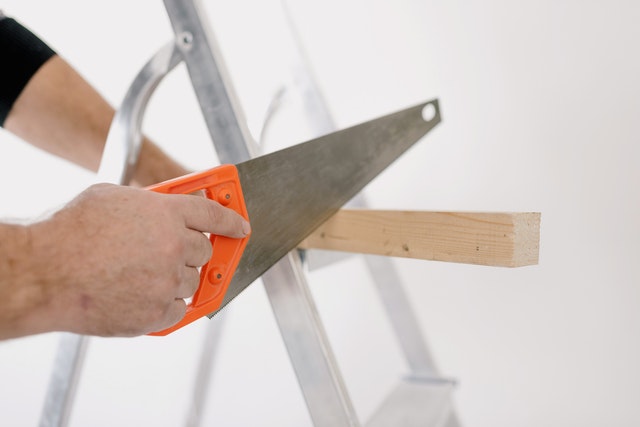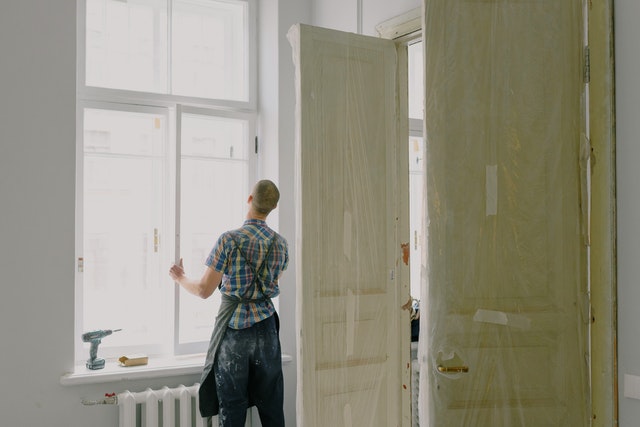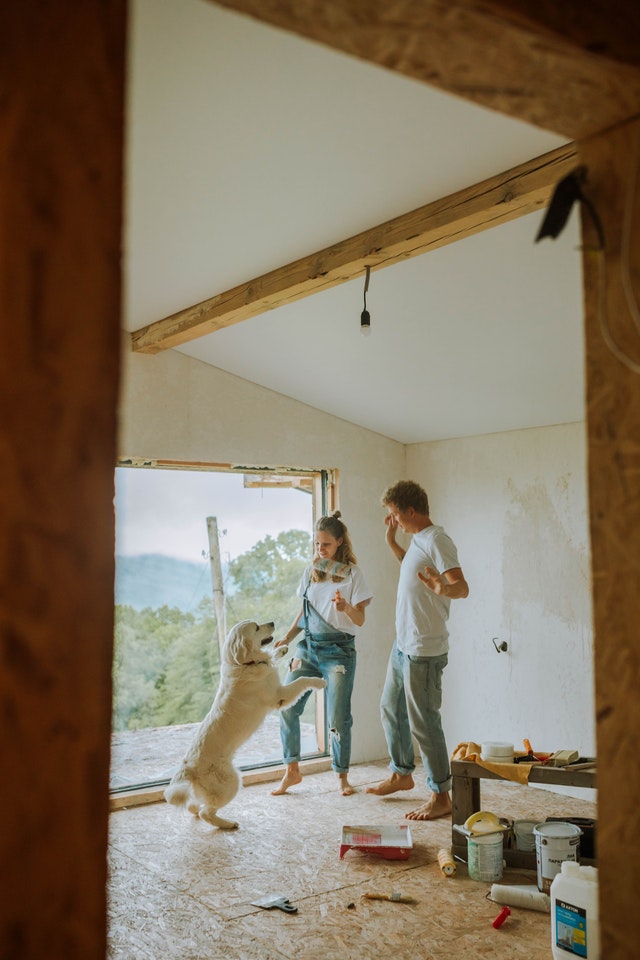Filling joints
The joints where two pieces of door or window casing meet at a corner sometimes separate. Caulking materials are used as fillers for open joints. There are many different types of caulk on the market. For filling cracks in wood, choose either plain latex or acrylic latex, as both of these are compatible with wood and can be painted.
Filling nail holes
Fill nail holes in new moldings and casings with wood filler or glazing compound. Push in a small bit with the edge of a putty knife or your finger. You can use the same technique for small nicks and dents in the wood. Sand if necessary.
Smoothing rough spots
Use a fine-grit sandpaper to smooth the rough spots. Before priming, wipe the surfaces with tack cloth or a damp rag. Allow to dry and then prime.
Filling openings
Fill a separated joint in a window casing with caulk. Apply it with a caulking gun. This will seal out both air and water. After you have filled the opening, wipe the surface smooth and prime.
Sanding difficult areas of wood
Smooth narrow areas, such as muntins, by cutting the sandpaper into strips and grasping the muntin between your thumb and forefinger. Sand in an up-and-down motion (or from side to side on horizontal muntins). Wipe with a cloth before priming.
Priming and painting woodwork
The right tools
Although the walls and ceilings of a room may make up a larger area, you need just as much precision when painting the woodwork of an average-size room. For moldings and casings, you’ll be using 2-inch brushes and spending a lot of time painting straight edges along walls and ceilings. Rather than masking these areas, use a straightedge to mask as you go.
Priming the surface
Apply a coat of primer to all bare wood before painting. The primer will seal the surface of the wood, preventing the paint from soaking in, and will provide a good base for the finish coats.
If a water-based primer has slightly raised the grain of the wood, sand with a fine-grit sandpaper and remove sanding dust with a damp rag before applying finish coats. Oil-based primers can also be used, even if you plan on applying a water-based paint as a finish coat. However, oil-based primers usually cannot be painted for 24 hours after they are applied (see p.24). Mask any adjoining surfaces that will not be painted.
When to prime moldings
Some professionals like to prime moldings before they are installed. Stand the section of molding on end or place it on a work surface covered with newspaper and then paint. Since there is no need to paint a straight edge, the primer will go on quickly. However, spot priming of repairs, such as filled nail holes, is still required.
Check the drying time
Be sure to check the label on the primer can to see when you can apply the finish coats. Although the primer must have time to dry completely, it is important to apply top coats as soon as possible after drying. Primers left uncovered for too long become poor paint surfaces.
Painting woodwork
When the primer is dry, sand lightly and wipe away the dust. Rough up the surface of painted wood with a fine-grit sandpaper or liquid deglosser before painting.
Painting moldings
Work from a stepladder or scaffolding. Start wherever you are most comfortable, but remember that right-handed painters will find it easier to work from left to right.
Painting built-ins
Bookcases, cabinets, and other built-ins should receive the same preparation as other woodwork. Use a washable-sheen paint on these areas. If possible, remove shelves before painting; otherwise, follow the sequence on page 87.
Priming Wood
Apply in the direction of the grain
Brush on primer with a 2-inch-wide brush in the direction of the wood grain. Don’t be concerned if it appears to be splotchy and uneven. The finishing coats of paint will smooth out the surface.
Avoiding Masking
Masking takes a great deal of time. To avoid masking, hold a straight-edge in your free hand to protect surfaces as you paint. To paint the baseboard, hold the straightedge to protect the floor covering.
Painting Woodwork
Painting ceiling moldings
Having primed, start in the corner with a 2-inch brush. Apply in the direction of the wood grain. Brush out with a wet brush and smooth without reloading it. At a new section, apply paint and brush back toward the wet edge. Feather the edge before moving to another section.
Painting chair-rail moldings
Be sure to protect the wall on both sides of the molding. For the narrow edges along the top and bottom, switch to a small pad or artist’s brush. Paint these sections while the main part of the molding is wet. Smooth out drips before moving to another section.
Painting intricate moldings
Use a stencil brush to fill the grooves and creases of elaborate molding designs. The round shape and closely spaced bristles of a stencil brush do a good job of forcing paint into every part of the design.
Painting baseboards
As with other woodwork, paint in the direction of the grain. Protect the floor with masking tape or heavy kraft paper.
Avoiding Lap Marks
1. Feather the edge
Lap marks show up more with a glossy paint. Since most woodwork is finished with a shiny surface, it is important to feather the edge. Brush the wood surface lightly with just the tips of the bristles, lifting the bristles as you reach the edge of a newly painted area.
keep a wet edge on woodwork
Paint woodwork in small sections, keeping a wet edge to avoid lap marks. Apply new paint in a dry area and work back toward previously applied paint. Brush in the direction of the grain.
Painting Shelves
Treat each shelf as a separate section. Complete an entire section before moving on to the next.
Work Sequence
- Starting at the top shelf, paint the back wall of the bookcase.
- Next, paint the sidewalls of the section you are working on.
- Then paint the upper and lower shelf surfaces.
- Complete the other sections in the same way.
- Finally, paint the exposed horizontal and vertical edges
Staining Woodwork
Apply the stain
Wear rubber gloves and protect the floors and walls by masking. Apply with a brush or a rag in the direction of the wood grain. Work in small sections so that you can control the level of stain penetration.
Wipe off the stain
Wait as directed on the label and then wipe off with a clean rag. As the work progresses, you will develop a sense of the time between application and wiping off. This will help you achieve an even finish.






